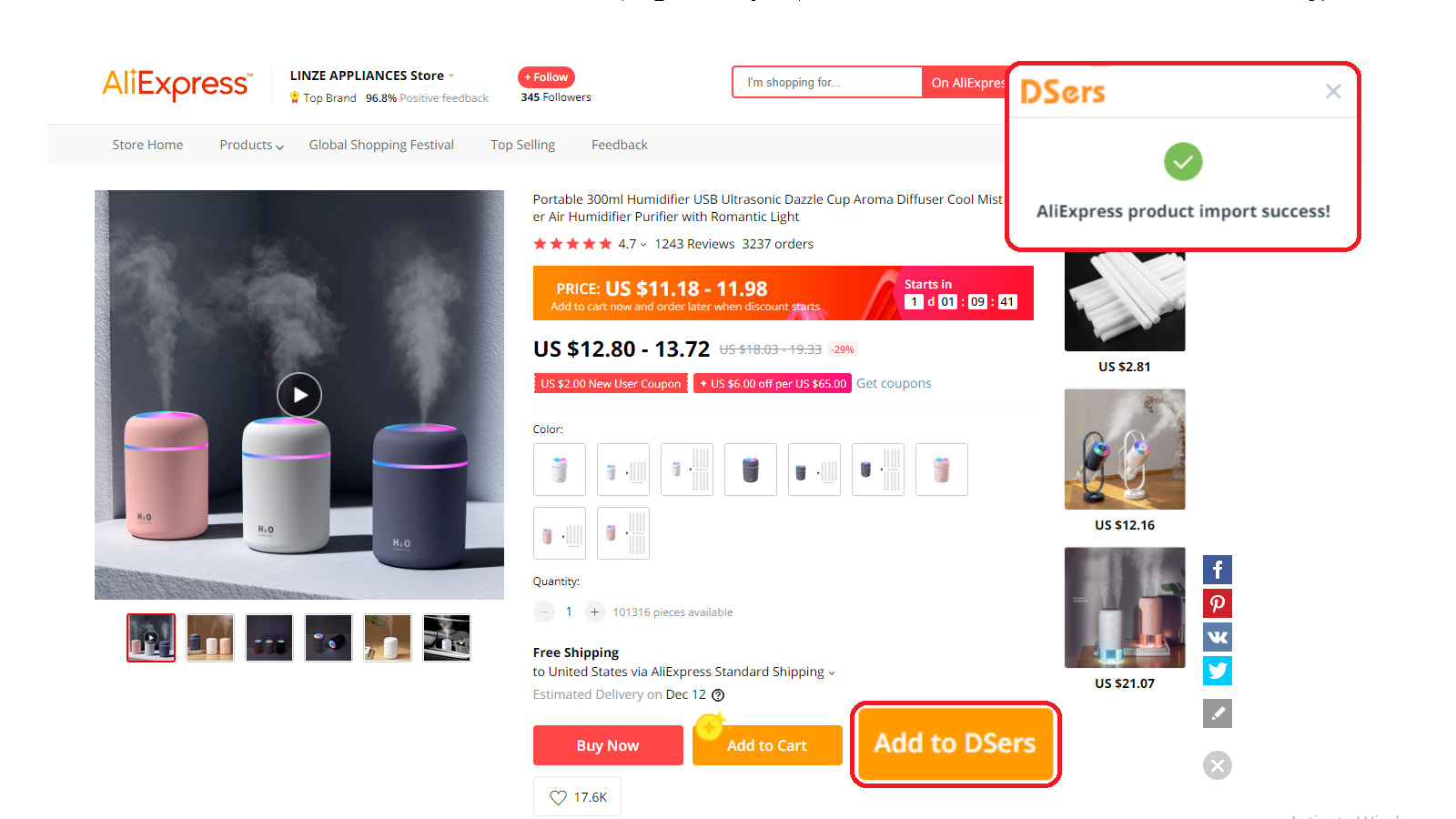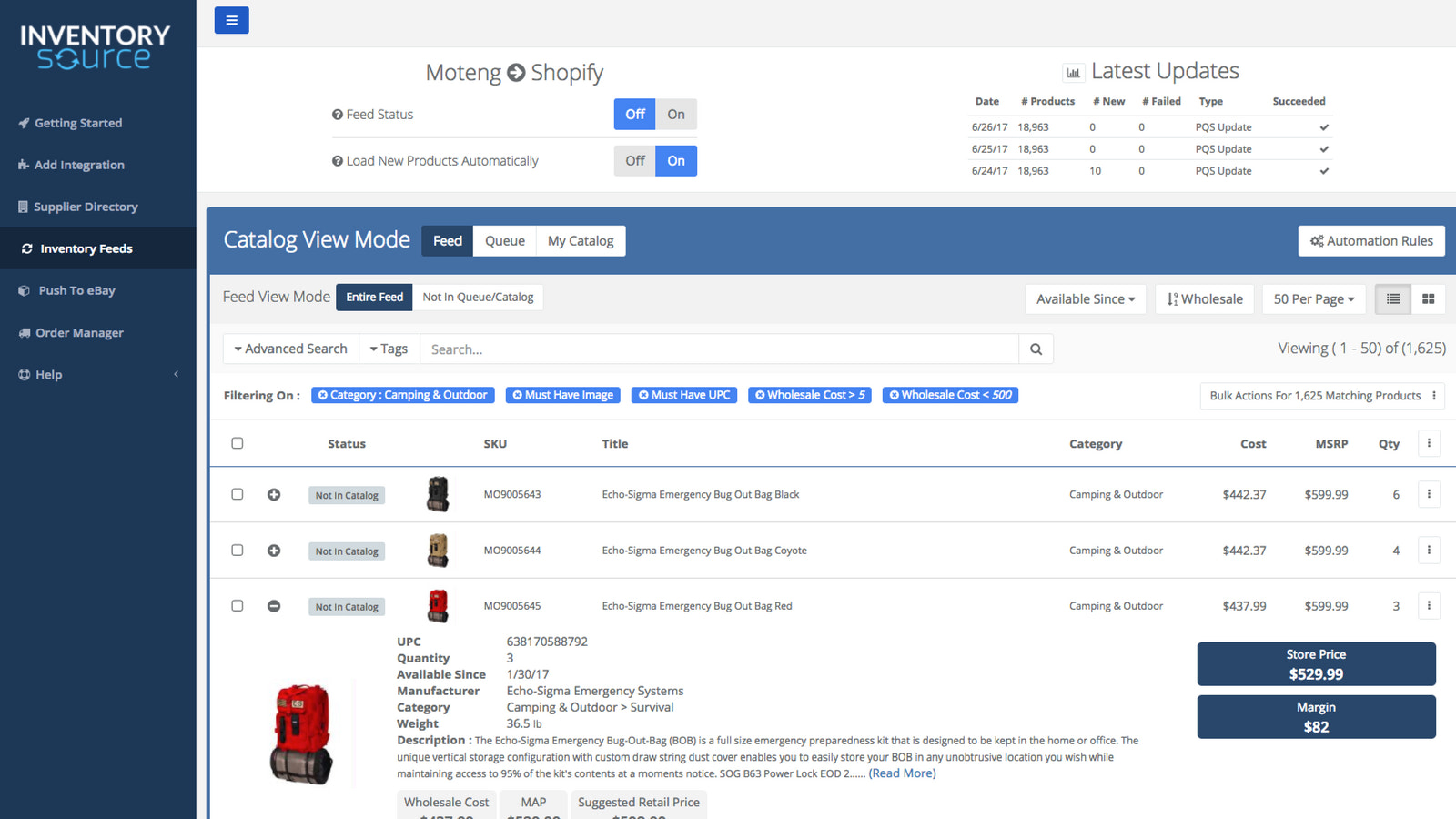If you want to run an online store without the stress of managing inventory, dropshipping is an attractive business model. But how do you find a supplier to provide customers with their products?
For most entrepreneurs, the answer is adropshippingwebsite or app. These platforms contain directories of suppliers and wholesalers, automate your orders, and often can handle fulfillment.
To help you find the right products for your ecommerce business, here are nine of the best dropshipping sites.
Table of Contents
What is a dropshipping business?
Dropshipping is anecommerce business modelwhere products sold by an online retailer are manufactured, warehoused, and shipped by a third-party dropshipping company.
Rather than purchasing large quantities of stock from a supplier, online stores will purchase a single item directly from the manufacturer after payment is transferred from the customer’s credit card.
Dropshipping has a ton of advantages for first-time business owners. In the initial stages of your business, you won’t have many employees, if any. Delegating order fulfillment to a third party helps free up time for marketing, customer support, and growing your brand.
Check outthesedropshipping tipsto boost your business.

How do dropshipping websites help your online store?
Since dropshipping delegates much of the grunt-work of starting a business to a third party, it has a lot of advantages if you’re looking togrow your retail business. Here are some of the benefits:
Low overhead costs
When youdropship products, you’re only paying for the productsafteryou’ve sold them, meaning you’ll never have to worry about sinking funds into over-stocking your inventory.
Less startup capital required
Startup costs for dropshipping businesses can be kept lower, since you don’t need to pay to have your products manufactured or stored. The added savings mean more budget can be allocated to assets likepaid ads, helping jump-start your growth.
Location flexibility
Since stock is managed by your dropshipper, there’s less need for you to be in a static location. You could work from home, your favorite café, or a secluded cabin deep in the woods (preferably one with decent Wi-Fi).
Fewer risks when testing new products
Most dropshipping sites highlight their bestselling products, meaning you already know what’s currently in high demand.
Saves time
Securing stock,inventory management, and shipping products takes a lot of time. With these tasks delegated to a third party, you can focus on marketing your products and building your brand.
The 9 best dropshipping websites
- DSers-AliExpress Dropshipping
- Spocket
- SaleHoo
- Zendrop
- Modalyst
- Trendsi
- Inventory Source
- Wholesale Central
- Worldwide Brands
It can be hard to know where to start when starting a dropshipping business. Even finding a dropshipping website to suit your needs can be overwhelming.
To take the stress out of this process, we’ve reviewed nine of the most popular dropshipping websites currently used by entrepreneurs.
1.DSers-AliExpress Dropshipping
When it comes to product variety, few dropshipping companies can compete with AliExpress. Launched in 2010, the online retail service features more than 100 million products, so you can find something to sell, no matter what niche you’re in.

If you plan ondropshipping with AliExpress, the best option is a Shopify store with theDSersdropshipping应用。免费计划,DSers-AliExpress plug-in allows you to explore AliExpress’s enormous collection of products and add them to your store in a few clicks.
- Price:Free for up to 3,000 products. The advanced plan starts at$19.90per month.
- Advantages:Large product variety, low cost, and easy to sync with your Shopify store.
- Disadvantages:AliExpress is one of the most commonly used dropshippers, so your products may be available at other retailers.
- Recommended for:New merchants with lower budgets who can build a strong brand and curate an appealing product line.
- Shopify app:Yes.
For AliExpress dropshipping, also tryAO‑AliExpress, built specifically for Shopify.
2.Spocket
Spocket is an order fulfillment service with a wide range of wholesale merchants, based mostly in the United States and Europe. But for international stores, this platform also has merchants in Canada, Asia, Australia, and Brazil.
With the Spocket app, you can browse merchants’ products and add them to your Shopify store in one click. Spocket also automates the entire order process, with products shipped to your customers at the point of purchase.

Spocket has abranded invoicefeature, which lets you create a custom invoice for your brand that’s shipped alongside your products. Branded packaging helps with brand awareness andcustomer retention(and is required forAmazon dropshipping).
- Price:To list up to 25 products, you’ll need the Starter plan, at $39.99 per month.
- Advantages:Spocket includes branded invoices that keep your business at the forefront of your customer’s minds. For select suppliers and customer locations, Sprocket offers fast shipping times.
- Disadvantages:Spocket can be pricey. Brand invoices are only available on the Pro plan, which offers fewer products at a higher price than alternative dropshipping apps.
- Recommended for:Merchants with startup funding who want to brand their own products.
- Shopify app:Yes.
3. SaleHoo

SaleHoo is a research tool and supplier directory for dropshippers, wholesalers, and ecommerce stores.
Its database includes over 8,000 wholesale distributors anddropshipping suppliers, with more than 2.5 million products.
With SaleHoo, merchants can access the platform’sMarket Research Lab,它提供了数据和销售创造一定的见解ts. You can see how well products have sold in other stores and online marketplaces likeeBayand Amazon before adding them to your own.
ALT= SaleHoo nav bar above images for products including suitcases, portable speakers, and socks.
SaleHoo also lets you see how many other retailers are selling each product, meaning you can factor in product availability when positioning your store’s brand. It’s a good resource for merchants looking to put their brand on high-demand products or offer exclusivity on products that are harder to find.
- Price:SaleHoo’s dropshipping features start at$27per month. Access to its database (without dropshipping features) costs $67 per year, or a one-time payment of $127.
- Advantages:SaleHoo gives in-depth information about available products.
- Disadvantages:Dropshipping features don’t integrate with Shopify or other ecommerce platforms, so you’ll need to manually import orders.
- Recommended for:While there’s no app, SaleHoo hasfree API resources. Data-focused merchants with experience in custom development can take advantage of this feature.
- Shopify app:No.
4.Zendrop
Zendrop is a popular Shopify app that offers both dropshipping and print-on-demand services. It’s a plug-in made by seasoned dropshippers, born out of common frustrations with other dropshipping websites, such as inconsistent suppliers and unpredictable shipping.
As a result, Zendrop has an intuitive interface for adding products to your site—many of which are stored in the US to enable five-to-eight day delivery. Merchants can also create custom packaging and subscription boxes to encourage repeat customers.

- Price:After a seven-day free trial, the Pro plan offers unlimited orders for$49per month.
- Advantages:US products, custom packaging, and a commitment to only working with reliable suppliers.
- Disadvantages:Zendrop is for Shopify merchants only, and is more expensive than some other apps.
- Recommended for:Shopify merchants looking for a seasoned middleman between their store and suppliers.
- Shopify app:Yes.
5.Modalyst
Modalyst is anautomated dropshippingapp known for carrying big-name brands. Selling products from companies your customers are familiar with gives a boost to your own brand and ups the trustworthiness of your website.
For US merchants, Modalyst offers a marketplace of suppliers that ships domestic orders in six to eight days. For global dropshippers, Modalyst wholesalers ship to more than 80 countries. The app also has an API partnership with AliExpress in the form of aChrome extension.

Modalyst curates collections of products made from sustainable materials from eco-friendly suppliers, for merchants looking to reduce their carbon footprint. Plus, you can add your own branding to your products, through itsprivate labeldropshipping program.
- Price:Modalyst’s free plan includes automation features for up to 25 products. For up to 250 products, it’s$35per month.
- Advantages:Modalyst is low cost. Although its free plan has a 25-product limit, it includes many of the automation features found in higher-priced competitors. It also has a large volume of products.
- Disadvantages:Products on Modalyst can be in short supply and sell out fast, especially if they’re from well-known brands. Some Shopify merchants have reported issues with the app version.
- Recommended for:Merchants on a tight budget looking for a low-cost way to sell products from known brands.
- Shopify app:Yes.
6.Trendsi
Many ecommerce stores cater to a specific audience orniche. For those merchants, it makes sense to find a supplier that focuses on the same product categories.
Trendsiis a wholesaler designed for merchants who sell women’s clothing in the US. The Shopify app ships more than 100,000 fashion products to customers in two to 10 days, with a branded invoice from your store.

Trendsi’s Luxe tier features even faster delivery and access to branded clothing, shoes, and accessories.
- Price:Trendsiisfreeto use, with fees incorporated into wholesale prices.
- Advantages:Specific product line for women’s clothing retailers. US-based products for faster shipping.
- Disadvantages:Smaller range of products than other dropshipping sites.
- Recommended for:Clothing merchants based in the US.
- Shopify app:Yes.
7.Inventory Source
Inventory Source is a dropshipping platform and order management tool that connects stores to suppliers without charging additional fees.

Since Inventory Source is primarily a stock management tool, it’s the only option on this list that allows you to add your own dropshippers—though custom integrations do come with an added cost.
- Price:Inventory automation plans start at$99per month.
- Advantages:A solution for merchants who already have suppliers and need to sync their inventory and order data.
- Disadvantages:Inventory Source can be quite expensive, and since it functions primarily as a tool, it’s better for merchants who have experience working with dropshippers. Shopify merchants have also reported problems with the latest update of the platform’s app.
- Recommended for:Merchants that already have established relationships with suppliers or who are looking to build more personal relationships with their suppliers.
- Shopify app:Yes.
8.Wholesale Central
Unlike other entries on this list, Wholesale Central is not an app or a platform. Instead, it’s a directory of dropshippers, suppliers, and wholesalers. For both buyers and suppliers, Wholesale Central offers an easy (if retro-looking) way to find tons of potential business partners.
在批发中心,店主可以浏览刺激ucts and suppliers, or search for products and suppliers by name. When they find a supplier they’re interested in working with, they’re provided with contact information.

Although Wholesale Central doesn’t offer anyinventory managementtools, it’s a free and vast resource that includes tons of dropshippers and suppliers that can provide your store with products.
- Price:Free.
- Advantages:Wholesale Central is a low-cost way to find suppliers that are open to building personal relationships with retailers.
- Disadvantages:Wholesale Central doesn’t include order-management tools to help sync orders and products with dropshippers.
- Recommended for:Merchants looking to partner with wholesalers and develop more personal business relationships.
- Shopify app:No.
9.Worldwide Brands
Established in 1999, Worldwide Brands is one of the oldest and most trusted supplier directories among veteran retailers. Dropshippers on Worldwide Brands must meet established quality-assurance guidelines.
Like Wholesale Central, Worldwide Brands is a directory of suppliers and dropshippers open to working with new retailers. It may not offer automation, but it does include more than 16 million certified wholesalers with a wide range of products, plus a dedicatedlist of certified dropshippers.
- Price:One-time payment of$187.
- Advantages:Strict inclusion criteria to create a list of reliable suppliers.
- Disadvantages:Worldwide Brands does not offer automation tools or an order management system, so syncing inventory can be a hassle.
- Recommended for:Store owners looking for trusted suppliers to partner with.
- Shopify app:No.
Learn moreabouthow to dropship on Amazon.
Other dropshipping sites worth considering
Doba
Doba dropshipping平台托管供应商based mostly in the United States and China. Doba’s most unique feature is its automated pricing rules. Rather than price products manually, merchants can create rules to price products at a fixed markup on the wholesale price. Plans start at$49.99per month after a free trial period. There’s also aShopify app.
Wholesale2b
Wholesale2b offers over a million products from more than 100 wholesale suppliers based primarily in the United States and Canada. Wholesale2b’s Shopify app pulls orders from your store, sends them to your selected dropshipper to be fulfilled, and even adds tracking information once the package is shipped—all automatically. It also has built-in integrations with Amazon and eBay. Pricing starts at$37.99per month.
How did we review these dropshipping sites?
Most dropshipping websites perform similar functions, but they differ when it comes to costs, product range, policies, and ease of use. For this list, we reviewed the best dropshipping sites by looking at:
- Product range and quality
- Service charges and fees
- Shipping times to customers
- Shopify merchant reviews
This list also compares the advantages and disadvantages of each site for merchants at different stages of their dropshipping careers.
Dropship branded products with print-on-demand services
If you’re an artist, designer, or creative entrepreneur, you might find that traditional dropshipping limits your ability to develop a unique brand. If that’s the case, you should consider usingprint-on-demand companiesto dropship custom products.
Print-on-demand dropshipping is a business model where you work with a supplier to customize and design your own products—usually easily printed objects like t-shirts, mugs, tote bags, posters, and fabrics.
Dropshipping vs. print on demand: which is better?
There are advantages to both dropshipping and print on demand. Bear in mind the following factors when choosing the right model for yourbusiness idea:
Product customization
Print on Demand |
Dropshipping |
Offers the ability to customize your products. |
Aside fromprivate labelgoods, there are few options to customize products. |
Brand awareness
Print on Demand |
Dropshipping |
Products can act as an advertisement, creating brand awareness when seen in public. |
Since products are typically unbranded, there are fewer opportunities to create brand awareness. |
Product range
Print on Demand |
Dropshipping |
Products are limited by printing requirements (usually t-shirts, blankets, mugs, posters, etc.) |
A wide range of products encompassing nearly every dropshipping niche, including fashion, electronics, home décor, etc. |
Product validation
Print on Demand |
Dropshipping |
Harder tovalidate your products, since unique designs will not have yet been sold. |
Validating products is easy, because you’ll be able to see popular items on your dropshipper’s website. |
Design requirements
Print on Demand |
Dropshipping |
Brand is built through your designs, meaning you’ll need design skills or to hire a designer. |
Brand is built through product curation. |
Unique products
Print on Demand |
Dropshipping |
Since products feature your own designs, they’re one of a kind and only available via your store and authorized partners. |
Since products are sourced, they are likely to be available at many retailers. |
If you’re a design-oriented merchant with artistic sensibilities, it can be rewarding to build your own brand with custom-designed products.
If your strength is in marketing, then you’re likely to havedropshipping success, which requires you to curate products rather than design them.
Either way, you’ll need an eye for branding. And keep in mind that you don’t need to limit yourself to just one model of order fulfillment. For example, you could build a fashion brand that includes your own custom-designed shirts alongside dropshipped accessories like jewelry, hats, and gloves.
Here’s whyprint on demand isa low risk way to sell custom t-shirts, books, and more.

What is the best way to start a dropshipping website?
If a dropshipping business is starting to look like the right option for you, you’re probably wondering where to get started. Let’s take a look at the steps to building a dropshipping store:
1. Find an idea
The first step to starting your business is coming up with aproduct idea. Remember that, with dropshipping, you’re curating products around a brand, so your primary focus should be on thevisual aspects of your brand.
Sometimes the dropshipper itself can serve as inspiration. You could try browsing some of its products and seeing if any fit together or compliment an under-served niche.
2. Perform market research
Once you have an idea, you’ll be able to identify your primary competitors and perform acompetitive analysis. A competitive analysis is an in-depth exploration of your competitors’ business strategies, target markets, branding, key features, price points, and website design.
Doing this will help you evaluate their strengths and weaknesses, and highlight opportunities to outperform them when developing your own brand.

Free: Competitive Analysis Template
By evaluating the strengths and weaknesses of your competition, you can begin to formulate how to give your company an advantage. Download our free competitive analysis template and gain an edge over the competition.
Get the competitive analysis template delivered right to your inbox.
Almost there: please enter your email below to gain instant access.
We'll also send you updates on new educational guides and success stories from the Shopify newsletter. We hate SPAM and promise to keep your email address safe.
3. Find a dropshipping supplier
With your market research done, your next step is finding adropshipping supplierthat carries the goods you need to build your brand. There are a ton of suppliers that can be found via the websites listed here, but keep in mind that you don’t have to use a single supplier.
Supplier directories like Wholesale Central and Worldwide Brands are great for finding retailers that carry specific products. They’re also good for brainstorming ideas and spotting under-served niches.
Many dropshipping companies connect directly to products in your Shopify store, so you can sell products from dropshippers alongside your own products.
4. Build your online store
With your dropshipper selected, you’re ready toOB欧宝娱乐APP开始你的网上商店欧宝体育官网入口首页. Remember that maintaining your store will be an ongoing process, so you can evolve your product line and branding based on what’s working.
Check out thisecommerce launch checklistto make sure you’ve got everything ready for your grand opening.
5. Market to your audience
With your store live, it’s time to bring in traffic. If you’ve built a social media following or online community, you can direct your existing customers to your store. In most cases you’ll need to start identifying yourtarget audience.
Find online communities dedicated to your product. Attend in-person trade shows and pass out business cards. If you don’t have any, use afree business card makerto create a custom one for the occasion.
Develop asocial media marketing strategyto build your following online. And don’t forget to stay tuned to the news in communities that connect with your product for stories ontrending productsin your industry.
Follow these simple stepstostart a dropshipping business.

Shopify makes it easy connect to dropshipping websites
When you start a Shopify store, you’ll be able to integrateproduct sourcing appsthat automate the process of shipping anddropshipping fulfillmentfor your online business.
Dropshipping products frees up time for you to focus on other important aspects of starting a business, like marketing, branding, and customer service. It also means you don’t have to pay for stock until it’s sold, making it nearly impossible to incur losses on products.
Ready to create your business? Start your free trial of Shopify—no credit card required.
Dropshipping websites FAQ
Which sites are best for dropshipping?
These nine sites are the best for dropshipping, based on product range, service charges, and reviews from Shopify merchants:
- DSers-AliExpress
- Spocket
- SaleHoo
- Zendrop
- Modalyst
- Trendsi
- Inventory Source
- Wholesale Central
- Worldwide Brands
What is the cheapest dropshipping website?
The cheapest dropshipping site is Wholesale Central, which is free. However, Wholesale Central is a directory of dropshippers who carry specific products, so the dropshippers themselves may still charge fees.
The cheapest dropshipping app is DSers‑AliExpress Dropshipping, which has a free plan that lets you add up to 3,000 products. Its Advanced plan—which allows up to 20,000 products and additional automation options—is the second-cheapest option, at $19.90 per month.
What are the best dropshipping products?
If you’re looking for thebest dropshipping products, most dropshippers will list their bestsellers on their website. Keep in mind that how well your products sell depends on outside factors, such as your marketing and business plan.
How profitable is dropshipping?
Dropshipping tends to be very profitable, because overhead costs can be kept low, since you don’t need to store or purchase stock before selling it.
Can I dropship from any website?
No, not all website-building platforms include features to integrate dropshipping. However, any website built on Shopify will let you integrate dropshipping features.Get started with Shopify.


